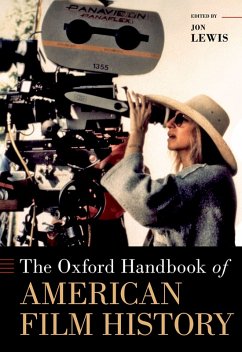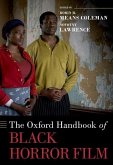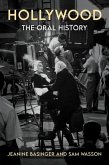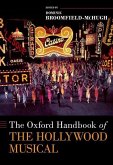The Oxford Handbook of American Film History
Herausgeber: Lewis, Jon
The Oxford Handbook of American Film History
Herausgeber: Lewis, Jon
- Gebundenes Buch
- Merkliste
- Auf die Merkliste
- Bewerten Bewerten
- Teilen
- Produkt teilen
- Produkterinnerung
- Produkterinnerung
In a series of newly commissioned chapters, The Oxford Handbook of American Film History offers a new and fully compelling discussion of American film as marked by significant moments of industrial and artistic change. Many of the chapters are built upon primary sourced research, while others detail aspects of form and style. Together, the chapters in this book show a history shaped by multiple theses and voices and interests.
Andere Kunden interessierten sich auch für
![The Oxford Handbook of Cinematic Listening The Oxford Handbook of Cinematic Listening]() The Oxford Handbook of Cinematic Listening225,99 €
The Oxford Handbook of Cinematic Listening225,99 €![The Oxford Handbook of Black Horror Film The Oxford Handbook of Black Horror Film]() The Oxford Handbook of Black Horror Film174,99 €
The Oxford Handbook of Black Horror Film174,99 €![The Oxford Handbook of American Documentary The Oxford Handbook of American Documentary]() The Oxford Handbook of American Documentary189,99 €
The Oxford Handbook of American Documentary189,99 €![The Oxford Handbook of Children's Film The Oxford Handbook of Children's Film]() The Oxford Handbook of Children's Film224,99 €
The Oxford Handbook of Children's Film224,99 €![Hollywood: The Oral History Hollywood: The Oral History]() Jeanine BasingerHollywood: The Oral History25,99 €
Jeanine BasingerHollywood: The Oral History25,99 €![The Oxford Handbook of Screen Comedy The Oxford Handbook of Screen Comedy]() The Oxford Handbook of Screen Comedy191,99 €
The Oxford Handbook of Screen Comedy191,99 €![The Oxford Handbook of the Hollywood Musical The Oxford Handbook of the Hollywood Musical]() The Oxford Handbook of the Hollywood Musical193,99 €
The Oxford Handbook of the Hollywood Musical193,99 €-
-
-
In a series of newly commissioned chapters, The Oxford Handbook of American Film History offers a new and fully compelling discussion of American film as marked by significant moments of industrial and artistic change. Many of the chapters are built upon primary sourced research, while others detail aspects of form and style. Together, the chapters in this book show a history shaped by multiple theses and voices and interests.
Produktdetails
- Produktdetails
- Verlag: Oxford University Press
- Seitenzahl: 840
- Erscheinungstermin: 2. September 2025
- Englisch
- Abmessung: 236mm x 180mm x 48mm
- Gewicht: 1497g
- ISBN-13: 9780197556122
- ISBN-10: 0197556124
- Artikelnr.: 73518552
- Herstellerkennzeichnung
- Libri GmbH
- Europaallee 1
- 36244 Bad Hersfeld
- gpsr@libri.de
- Verlag: Oxford University Press
- Seitenzahl: 840
- Erscheinungstermin: 2. September 2025
- Englisch
- Abmessung: 236mm x 180mm x 48mm
- Gewicht: 1497g
- ISBN-13: 9780197556122
- ISBN-10: 0197556124
- Artikelnr.: 73518552
- Herstellerkennzeichnung
- Libri GmbH
- Europaallee 1
- 36244 Bad Hersfeld
- gpsr@libri.de
Jon Lewis is the University Distinguished Professor of Film Studies at Oregon State University. He is the author of Hollywood v. Hard Core: How the Struggle over Censorship Saved the Modern Film Industry, Hard-Boiled Hollywood: Crime and Punishment in Postwar Los Angeles, and Road Trip to Nowhere: Hollywood Encounters the Counterculture.
* Introduction
* Part 1. Early and Silent Cinema-1895-1927
* Chapter 1: "All Things Go: Travel Imaginaries, Letter Sheets, and the
Emergence of Cinema"
* Chapter 2: Transition's Longue Duréeand the Historiographical
Vagaries of Silent American Cinema
* Chapter 3: 16mm Hollywood
* Chapter 4: "The Conquest of Paris": Making French Cinema American,
1910-1925
* Chapter 5: Slapstick as Media History, or, the Joke in the Machine
* Chapter 6: "Rethinking Uplift and Class in Early Black American
Cinema"
* Chapter 7: When "Orientals" Become "Indians": Gender, Race,
Masquerade in Frontier Silent Films
* Part 2. Classical Hollywood-1928-1946
* Chapter 8: The Classical Hollywood Studio Era: A Case Study of Warner
Brothers
* Chapter 9: The Sound of Movement
* Chapter 10: The MGM Woman's Film 1928-1947
* Chapter 11: Managing the Classical Hollywood Musical's Dancing
Bodies: "Morality" and Glamour
* Chapter 12: Hollywood Gangsters: Crime, Punishment, and Movieland
Celebrity
* Chapter 13: License Revoked? Orson Welles's Studio Films of the
Mid-Forties
* Part 3. The Postwar Transition-1947-1967
* Chapter 14: "Image Management and the Fall of Hollywood's Golden Age"
* Chapter 15: Selling Noir's "Red Meat" to the Female Market
* Chapter 16: Efficient Alfred: Hitchcock's Technical Images, 1946-1964
* Chapter 17: Becoming Queen: Barbara Stanwyck's Postwar Westerns
* Chapter 18: The Square Screen: A Look at the Unhip Cinema of the
1960s
* Chapter 19: "'Who Do I Have to Fuck to Get off This Picture?' Roger
Corman as Progressive Exploitation Auteur"
* Part 4. The New Hollywood(s)-1968-1999
* Chapter 20: "Industrial Signposts to New Hollywood's Demise: First
Artists, the Directors Company and United Artists"
* Chapter 21: The End of the World (As It Is Collectively Known at the
Time): Hit Patterns in US and Global Box-Office Charts
* Chapter 22: "Men Produce, Women Develop": Feminized Story Labor,
Executive Power and the "D-Girl" In New Hollywood
* Chapter 23: Foxtrot Tango Alpha: Jane Fonda's New Hollywood
* Chapter 24: Changing the Conversation: Black Film Discourse in 1970s
New York
* Chapter 25: Male Fusion: Cronenberg's Masculinities, The Fly, and the
First AIDS Era
* Chapter 26: "A short little Hebrew man" with "a scintilla of
homosexuality": Mel Brooks's Queer Comedy and Vulgar Humanism, from
The Producers (1967) to The Producers (2005)
* Chapter 27: Genderqueer Approaches to Blaxploitation
* Part 5. Converging Media-2000-2023
* Chapter 28: "Fin-dies," Filmanthropy, and the Financialization of
Indie Film
* Chapter 29: From Tentpoles to Universes: Hollywood's Evolving
Franchise Strategy
* Chapter 30: The Disintegration Effect
* Chapter 31: "Dark Money Documentaries"
* Chapter 32: Forward-looking Statements, or, The Content of the
Content
* Part 1. Early and Silent Cinema-1895-1927
* Chapter 1: "All Things Go: Travel Imaginaries, Letter Sheets, and the
Emergence of Cinema"
* Chapter 2: Transition's Longue Duréeand the Historiographical
Vagaries of Silent American Cinema
* Chapter 3: 16mm Hollywood
* Chapter 4: "The Conquest of Paris": Making French Cinema American,
1910-1925
* Chapter 5: Slapstick as Media History, or, the Joke in the Machine
* Chapter 6: "Rethinking Uplift and Class in Early Black American
Cinema"
* Chapter 7: When "Orientals" Become "Indians": Gender, Race,
Masquerade in Frontier Silent Films
* Part 2. Classical Hollywood-1928-1946
* Chapter 8: The Classical Hollywood Studio Era: A Case Study of Warner
Brothers
* Chapter 9: The Sound of Movement
* Chapter 10: The MGM Woman's Film 1928-1947
* Chapter 11: Managing the Classical Hollywood Musical's Dancing
Bodies: "Morality" and Glamour
* Chapter 12: Hollywood Gangsters: Crime, Punishment, and Movieland
Celebrity
* Chapter 13: License Revoked? Orson Welles's Studio Films of the
Mid-Forties
* Part 3. The Postwar Transition-1947-1967
* Chapter 14: "Image Management and the Fall of Hollywood's Golden Age"
* Chapter 15: Selling Noir's "Red Meat" to the Female Market
* Chapter 16: Efficient Alfred: Hitchcock's Technical Images, 1946-1964
* Chapter 17: Becoming Queen: Barbara Stanwyck's Postwar Westerns
* Chapter 18: The Square Screen: A Look at the Unhip Cinema of the
1960s
* Chapter 19: "'Who Do I Have to Fuck to Get off This Picture?' Roger
Corman as Progressive Exploitation Auteur"
* Part 4. The New Hollywood(s)-1968-1999
* Chapter 20: "Industrial Signposts to New Hollywood's Demise: First
Artists, the Directors Company and United Artists"
* Chapter 21: The End of the World (As It Is Collectively Known at the
Time): Hit Patterns in US and Global Box-Office Charts
* Chapter 22: "Men Produce, Women Develop": Feminized Story Labor,
Executive Power and the "D-Girl" In New Hollywood
* Chapter 23: Foxtrot Tango Alpha: Jane Fonda's New Hollywood
* Chapter 24: Changing the Conversation: Black Film Discourse in 1970s
New York
* Chapter 25: Male Fusion: Cronenberg's Masculinities, The Fly, and the
First AIDS Era
* Chapter 26: "A short little Hebrew man" with "a scintilla of
homosexuality": Mel Brooks's Queer Comedy and Vulgar Humanism, from
The Producers (1967) to The Producers (2005)
* Chapter 27: Genderqueer Approaches to Blaxploitation
* Part 5. Converging Media-2000-2023
* Chapter 28: "Fin-dies," Filmanthropy, and the Financialization of
Indie Film
* Chapter 29: From Tentpoles to Universes: Hollywood's Evolving
Franchise Strategy
* Chapter 30: The Disintegration Effect
* Chapter 31: "Dark Money Documentaries"
* Chapter 32: Forward-looking Statements, or, The Content of the
Content
* Introduction
* Part 1. Early and Silent Cinema-1895-1927
* Chapter 1: "All Things Go: Travel Imaginaries, Letter Sheets, and the
Emergence of Cinema"
* Chapter 2: Transition's Longue Duréeand the Historiographical
Vagaries of Silent American Cinema
* Chapter 3: 16mm Hollywood
* Chapter 4: "The Conquest of Paris": Making French Cinema American,
1910-1925
* Chapter 5: Slapstick as Media History, or, the Joke in the Machine
* Chapter 6: "Rethinking Uplift and Class in Early Black American
Cinema"
* Chapter 7: When "Orientals" Become "Indians": Gender, Race,
Masquerade in Frontier Silent Films
* Part 2. Classical Hollywood-1928-1946
* Chapter 8: The Classical Hollywood Studio Era: A Case Study of Warner
Brothers
* Chapter 9: The Sound of Movement
* Chapter 10: The MGM Woman's Film 1928-1947
* Chapter 11: Managing the Classical Hollywood Musical's Dancing
Bodies: "Morality" and Glamour
* Chapter 12: Hollywood Gangsters: Crime, Punishment, and Movieland
Celebrity
* Chapter 13: License Revoked? Orson Welles's Studio Films of the
Mid-Forties
* Part 3. The Postwar Transition-1947-1967
* Chapter 14: "Image Management and the Fall of Hollywood's Golden Age"
* Chapter 15: Selling Noir's "Red Meat" to the Female Market
* Chapter 16: Efficient Alfred: Hitchcock's Technical Images, 1946-1964
* Chapter 17: Becoming Queen: Barbara Stanwyck's Postwar Westerns
* Chapter 18: The Square Screen: A Look at the Unhip Cinema of the
1960s
* Chapter 19: "'Who Do I Have to Fuck to Get off This Picture?' Roger
Corman as Progressive Exploitation Auteur"
* Part 4. The New Hollywood(s)-1968-1999
* Chapter 20: "Industrial Signposts to New Hollywood's Demise: First
Artists, the Directors Company and United Artists"
* Chapter 21: The End of the World (As It Is Collectively Known at the
Time): Hit Patterns in US and Global Box-Office Charts
* Chapter 22: "Men Produce, Women Develop": Feminized Story Labor,
Executive Power and the "D-Girl" In New Hollywood
* Chapter 23: Foxtrot Tango Alpha: Jane Fonda's New Hollywood
* Chapter 24: Changing the Conversation: Black Film Discourse in 1970s
New York
* Chapter 25: Male Fusion: Cronenberg's Masculinities, The Fly, and the
First AIDS Era
* Chapter 26: "A short little Hebrew man" with "a scintilla of
homosexuality": Mel Brooks's Queer Comedy and Vulgar Humanism, from
The Producers (1967) to The Producers (2005)
* Chapter 27: Genderqueer Approaches to Blaxploitation
* Part 5. Converging Media-2000-2023
* Chapter 28: "Fin-dies," Filmanthropy, and the Financialization of
Indie Film
* Chapter 29: From Tentpoles to Universes: Hollywood's Evolving
Franchise Strategy
* Chapter 30: The Disintegration Effect
* Chapter 31: "Dark Money Documentaries"
* Chapter 32: Forward-looking Statements, or, The Content of the
Content
* Part 1. Early and Silent Cinema-1895-1927
* Chapter 1: "All Things Go: Travel Imaginaries, Letter Sheets, and the
Emergence of Cinema"
* Chapter 2: Transition's Longue Duréeand the Historiographical
Vagaries of Silent American Cinema
* Chapter 3: 16mm Hollywood
* Chapter 4: "The Conquest of Paris": Making French Cinema American,
1910-1925
* Chapter 5: Slapstick as Media History, or, the Joke in the Machine
* Chapter 6: "Rethinking Uplift and Class in Early Black American
Cinema"
* Chapter 7: When "Orientals" Become "Indians": Gender, Race,
Masquerade in Frontier Silent Films
* Part 2. Classical Hollywood-1928-1946
* Chapter 8: The Classical Hollywood Studio Era: A Case Study of Warner
Brothers
* Chapter 9: The Sound of Movement
* Chapter 10: The MGM Woman's Film 1928-1947
* Chapter 11: Managing the Classical Hollywood Musical's Dancing
Bodies: "Morality" and Glamour
* Chapter 12: Hollywood Gangsters: Crime, Punishment, and Movieland
Celebrity
* Chapter 13: License Revoked? Orson Welles's Studio Films of the
Mid-Forties
* Part 3. The Postwar Transition-1947-1967
* Chapter 14: "Image Management and the Fall of Hollywood's Golden Age"
* Chapter 15: Selling Noir's "Red Meat" to the Female Market
* Chapter 16: Efficient Alfred: Hitchcock's Technical Images, 1946-1964
* Chapter 17: Becoming Queen: Barbara Stanwyck's Postwar Westerns
* Chapter 18: The Square Screen: A Look at the Unhip Cinema of the
1960s
* Chapter 19: "'Who Do I Have to Fuck to Get off This Picture?' Roger
Corman as Progressive Exploitation Auteur"
* Part 4. The New Hollywood(s)-1968-1999
* Chapter 20: "Industrial Signposts to New Hollywood's Demise: First
Artists, the Directors Company and United Artists"
* Chapter 21: The End of the World (As It Is Collectively Known at the
Time): Hit Patterns in US and Global Box-Office Charts
* Chapter 22: "Men Produce, Women Develop": Feminized Story Labor,
Executive Power and the "D-Girl" In New Hollywood
* Chapter 23: Foxtrot Tango Alpha: Jane Fonda's New Hollywood
* Chapter 24: Changing the Conversation: Black Film Discourse in 1970s
New York
* Chapter 25: Male Fusion: Cronenberg's Masculinities, The Fly, and the
First AIDS Era
* Chapter 26: "A short little Hebrew man" with "a scintilla of
homosexuality": Mel Brooks's Queer Comedy and Vulgar Humanism, from
The Producers (1967) to The Producers (2005)
* Chapter 27: Genderqueer Approaches to Blaxploitation
* Part 5. Converging Media-2000-2023
* Chapter 28: "Fin-dies," Filmanthropy, and the Financialization of
Indie Film
* Chapter 29: From Tentpoles to Universes: Hollywood's Evolving
Franchise Strategy
* Chapter 30: The Disintegration Effect
* Chapter 31: "Dark Money Documentaries"
* Chapter 32: Forward-looking Statements, or, The Content of the
Content








